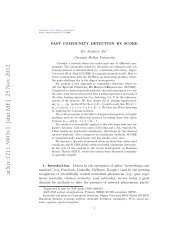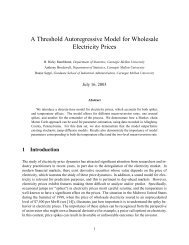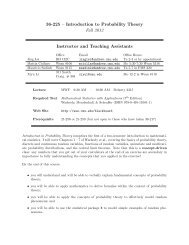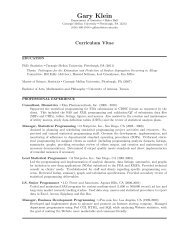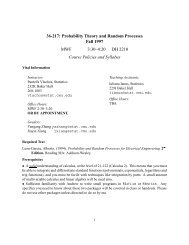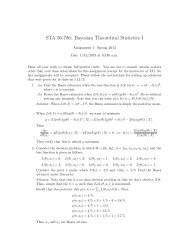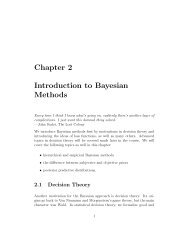Subjective Bayesian Analysis: Principles and Practice
Subjective Bayesian Analysis: Principles and Practice
Subjective Bayesian Analysis: Principles and Practice
You also want an ePaper? Increase the reach of your titles
YUMPU automatically turns print PDFs into web optimized ePapers that Google loves.
ESP” over the net, which makes for some intriguing reading. Here’s a particularly relevant<br />
discussion from an article in the September 2002 issue of Scientific American, by Michael<br />
Sherme, titled “Smart People Believe Weird Things”. After noting that, for example, around<br />
60% of college graduates appear to believe in ESP, Sherme reports the results of a study that<br />
found “no correlation between science knowledge (facts about the world) <strong>and</strong> paranormal<br />
beliefs. The authors, W. Richard Walker, Steven J. Hoekstra <strong>and</strong> Rodney J. Vogl, concluded:<br />
“Students that scored well on these [science knowledge] tests were no more or less sceptical of<br />
pseudo-scientific claims than students that scored very poorly. Apparently, the students were<br />
not able to apply their scientific knowledge to evaluate these pseudo-scientific claims. We<br />
suggest that this inability stems in part from the way that science is traditionally presented<br />
to students: Students are taught what to think but not how to think.” Sherme continues<br />
as follows. “To attenuate these paranormal belief statistics, we need to teach that science<br />
is not a database of unconnected factoids but a set of methods designed to describe <strong>and</strong><br />
interpret phenomena, past or present, aimed at building a testable body of knowledge open<br />
to rejection or confirmation.”<br />
The subjective <strong>Bayesian</strong> approach may be viewed as a formal method for connecting<br />
experimental factoids. Rather than treating each data set as though it has no wider context,<br />
<strong>and</strong> carrying out each statistical analysis just as though this were the first investigation that<br />
had ever been carried out of any relevance to the questions at issue, we consider instead how<br />
the data in question adds to, or changes, our beliefs about these questions.<br />
If we think about the ESP experiment in this way, then we should exp<strong>and</strong> the problem<br />
description to reflect this requirement. Here is a minimum that I should consider. First, I<br />
would need to assess my probability for E, the event that ESP is a real phenomenon that at<br />
least some people possess. This is the event that joins my analysis of Harry’s performance<br />
with my generalised knowledge of the scientific phenomenon at issue. Conditional on E, I<br />
should evaluate my probability for J, the event that Harry possesses ESP. Conditional on J<br />
<strong>and</strong> on J complement, I should evaluate my probabilities for G, the event that Harry is just<br />
guessing <strong>and</strong> C, the event that either the experiment is flawed or Harry is, somehow, cheating;<br />
for example, the coin might be heads biased <strong>and</strong> Harry mostly calls heads. This is the event<br />
that captures my generalised knowledge of the reliability of experimental procedures in this<br />
area. If there is either cheating or ESP, I need a probability distribution over the magnitude<br />
of the effect.<br />
What do we achieve by this formalism? Firstly, this gives me a way of assessing my actual<br />
posterior probability for whether Harry has ESP. Secondly, if I can lay out the considerations<br />
that I use in a transparent way, it is easy for you to see how your conclusions might differ<br />
from mine. If we disagree as to whether Harry has ESP, then we can trace this disagreement<br />
back to differing probabilities for the general phenomenon, in this case ESP, or different<br />
judgements about particulars of the experiment, such as Harry’s possible ability at sleight of<br />
h<strong>and</strong>. More generally, by considering the range of prior judgements that might reasonably<br />
be made, I can distinguish between the extent to which the experiment might convince me<br />
as to Harry’s ESP, <strong>and</strong> the effect it might have on others. I could even determine how large<br />
<strong>and</strong> how stringently controlled an experiment would need to be in order to have a chance of<br />
convincing me of Harry’s powers. More generally, how large would the experiment need to<br />
be to convince the wider community?<br />
The above example provides a simple version of a general template for any scientific<br />
<strong>Bayesian</strong> analysis. There are scientific questions at issue. Beliefs about these issues require<br />
prior specification. Then we must consider the relevance of the scientific formulation to the<br />
current experiment along with all the possible flaws in the experiment which would invalidate<br />
the analysis. Finally, a likelihood must be specified, expressing data variability given<br />
the hypotheses of interest. There are two versions of the subsequent analysis. Firstly, you<br />
6



